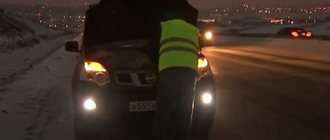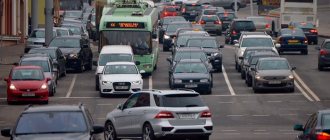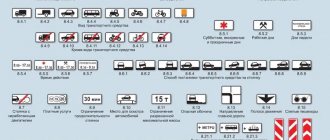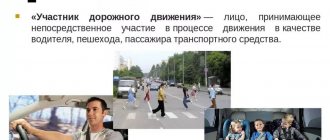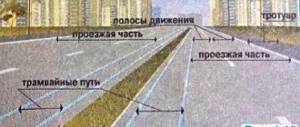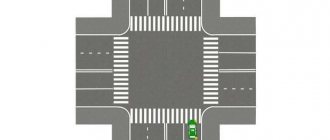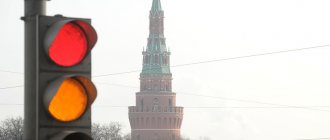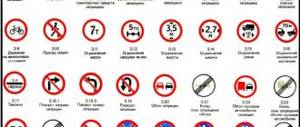All motorists know that turning around, stopping and parking at stopping places for route vehicles is prohibited, but sometimes questions arise with the designation of this place and how exactly to determine the boundaries of stopping prohibitions. Below we will consider all possible ways to designate stops for route vehicles.
MTS stops are indicated by road signs 5.16 “Bus and (or) trolleybus stopping place”, 5.17 “Tram stopping place” and (or) road markings 1.17. and (or) road markings 1.17. Please note that the markings do not duplicate the sign and can be used independently.
MTS stop sign only
8.11. U-turn is prohibited:
in places where route vehicles stop.
12.4. Stopping is prohibited:
closer than 15 meters from the stopping places of fixed-route vehicles or parking for passenger taxis, indicated by marking 1.17, and in its absence - from the sign of the stopping place of fixed-route vehicles or parking for passenger taxis (except for stops for boarding and disembarking passengers, if this does not interfere with the movement of fixed-route vehicles vehicles or vehicles used as passenger taxis);
The MTS stop location is indicated only by a sign.
Please note that the MTS stop location begins after the sign. According to GOST, sign 5.16 is installed at the beginning of the landing area, that is, the stopped route vehicle will be located completely after the sign. This prevents the bus from blocking the visibility of the sign. This is important when making a turn. Turning around before the sign is not prohibited. Turning is prohibited only at MTS stops - from the far right lane and into the far right lane.
- If the stopping place for route vehicles is indicated only by a sign, then the prohibited stopping and parking zone is determined by 15 meters before and after the sign in the direction of travel for which the sign is installed. Stopping on the opposite side of the road is not prohibited.
Stop on the opposite side of the road from the MTS stop
Prohibitions in places where public transport stops.
The concept under consideration is “ Stopping point for route vehicles .”
In clause 1.2. The traffic rules, which contain definitions of the basic concepts and terms used in the traffic rules, do not have a definition of this concept. However, in the text of the traffic rules, certain restrictions apply to sections of the roadway where route vehicles stop. Thus, clause 8.11 of the traffic rules contains a ban on turning around at places where route vehicles stop, clause 8.12 of the traffic rules contains a ban on reversing in these areas, and clause 12.14. Traffic regulations and paragraph 12. 15 of traffic regulations prohibit stopping and parking, respectively.
According to clause 12.14 of the traffic rules, stopping is prohibited closer than 15 meters from the stopping places of route vehicles, marked with marking 1.17, and in its absence - from the sign of the stopping place of route vehicles (except for cases of boarding or disembarking passengers, if this does not interfere with the movement of route vehicles Vehicle). Thus, stopping and parking is prohibited 15 meters before the stop sign or the beginning of marking 1.17 and 15 meters after the sign or the end of marking 1.17. Although “closer than 15 meters” can be interpreted as just before the markings or sign. And some interpret the expression “closer than 15 meters” as a circle with a radius of 15 meters with a center at the location of the sign. This version does not stand up to any criticism, since half of this circle is outside the roadway, and the other half of this circle does not always cover the same section of the road. Sometimes it also includes a section intended for oncoming traffic and even the oncoming shoulder, this is if the width of the road is insignificant, and sometimes only passing lanes, this is when the road is wide and has many lanes for traffic in a given direction. In addition, this paragraph does not directly prohibit stopping at the actual stopping place for route vehicles. Probably, the legislator decided that this follows from the very concept of “stopping place for route vehicles,” because the traffic rules say that this is a place for stopping a route vehicle and, accordingly, this should mean that other vehicles are prohibited from stopping at this place, but this For some reason the concept is not enshrined in the traffic rules.
Regarding clauses 8.11 and clauses 8.12, there is almost a complete gap in the traffic rules. So, to fulfill these points, you need to clearly know the boundaries of the stop of route vehicles, its length and width.
MTS stop designation with signs and markings
If the marking 1.17 is present in the designation of the MTS stop location, then no controversial issues arise. When turning around, it is prohibited to enter this marking, and to stop and park you must retreat 15 meters on both sides in the direction of travel.
Marking the MTS stop location with signs and markings
Signs and designations
By definition, any bus stop must have a sign. It could be:
- road marking 1.17, which is a yellow zigzag line;
- sign 5.16 “Bus and (or) trolleybus stop”;
- sign 5.17 “Tram stopping place.”
According to OST 218.1.002-2003, signs are installed in front of the landing site and must be double-sided.
This is done to inform not only drivers of passing cars, but also oncoming people that they are approaching a special section of the road, because there is often a pedestrian crossing near bus stops. As for the markings, they are applied along the entire length of the stop, i.e. its length is 15 meters or more.
Unmarked MTS stopping places
The above requirements of the Road Traffic Rules apply only to those indicated
stops of route vehicles and passenger taxis. If the stopping place is not marked with an appropriate sign and/or markings, turning around and stopping at such places is not prohibited.
Crowded places and arrangement on the sidewalk are not a sign of an MTS stop
The presence of route signs and transport schedules is not a sign of MTS stopping
More details about the stopping place
A public transport stop is a designated section of road used for picking up and unloading passengers. According to the law, a 15-meter space is allocated for it. The following can stop at such a site:
- route vehicles (bus, trolleybus, tram);
- passenger taxis.
Stops must be equipped in accordance with the general technical requirements for them.
Most often, covered pavilions with benches, trash cans and transport schedules are installed in such places.
Experimental marking of tram stop locations
When organizing tram traffic with passengers disembarking on the roadway, for experimental purposes, in some places markings were applied to the right of the tram tracks along the left edge of the roadway.
Tram stop markings
This use of markup is for informational purposes only. Stopping in such a place is prohibited according to the general rules, and turning around without entering the tram tracks at the place where the tram stops will not work, that is, the markings do not affect the formation of a violation.
Is it possible to stop and stand at a bus stop?
According to clause 12.4 of the Traffic Rules of the Russian Federation, the driver does not have the right to park the car near organized public transport stops. The law specifies a specific distance - 15 m (before and after a stationary stop). Thus, a minimum of 15 meters of distance, as well as the designated stopping point itself, must remain free for the access of buses or trolleybuses.
We are talking about parking next to the stop, marked and not marked with special yellow markings 1.17.1 on the asphalt. If there are no markings, you should focus on road sign 5.16 with the image of a bus or trolleybus, which is installed in places intended for public transport stops.
Stopping means keeping the vehicle stationary for 5 minutes. If the car does not move for a longer period of time, the vehicle is considered parked (in the parking lot).
Is it allowed to pick up or drop off passengers?
Yes . There are exceptional situations in which a temporary stop at such areas is permissible. The rules do not prohibit stopping to drop off or pick up passengers, but there is an important caveat: the car must not in any way impede the operation of public transport (arrival or departure of buses, boarding or disembarking of passengers).
The car can be temporarily stopped not only to unload passengers, but also to unload or load things.
You can stop only in those areas where there is no special sign 3.27, prohibiting stopping for any reason.
Forced stop at a public transport stop
The law does not prohibit forced stops:
- in case of breakdown : if the car breaks down and the nearest point where it is possible to park the faulty vehicle is a bus stop, then the driver stops in this zone*;
- in case of a sharp deterioration in health : if the driver suddenly becomes ill while driving, he has the right to stop at any place (including a bus or trolleybus stop) so as not to create emergency and dangerous situations;
- during anti-emergency maneuvers : if the stop occurred as a result of a maneuver aimed at preventing an emergency situation on the road, such a decision by the driver is considered legal.
* If the vehicle breaks down, the driver is obliged to stop the vehicle, place a warning triangle on the roadway and begin troubleshooting. The law contains an instruction: a person driving a faulty car is obliged to take all possible measures so as not to violate the Traffic Rules and not park in places prohibited by law. The law describes specific examples of malfunctions that may cause a stop in an unintended place:
- Malfunction of the brake or steering system.
- Breakdown of windshield wipers (if the weather requires the use of windshield wipers while driving).
- Malfunction of lighting devices (especially if the car is driven at night).
If the driver cannot cope with the problems on his own, you need to call a tow truck or seek the help of a visiting team of specialists.
If the driver becomes ill, it is necessary to notify other road users or passers-by about his condition in any way.
Are taxis allowed to park at stops?
The law makes no exceptions for drivers of passenger taxis: a taxi driver has the right to stop briefly in a public transport area if there is a need to drop off or pick up passengers (unload or load things). It is important not to interfere with buses arriving or departing from a stationary stop.

